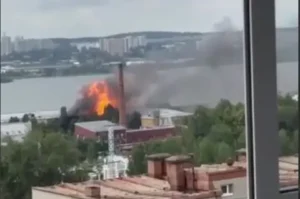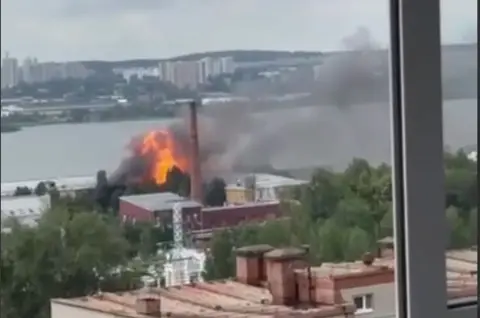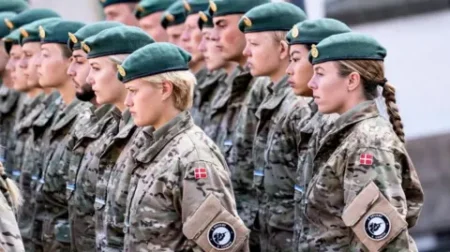**Ukrainian Drone Attack on Central Russia: An Escalation of the Ongoing Conflict**
In a deeply concerning escalation of military hostilities, reports confirm that three individuals lost their lives, and 35 others were hospitalized due to a drone attack orchestrated by Ukrainian forces on a factory located in Izhevsk, a city situated over 1,000 kilometers (approximately 620 miles) from the Ukrainian border. This incident marks a significant progression in the ongoing conflict between Russia and Ukraine, particularly as the targeted site, the Kupol Electromechanical Plant, has strategic importance, reportedly producing military equipment such as the Tor surface-to-air missile systems and radar technologies.
Details surrounding the attack have emerged from various officials, including Udmurtia’s governor, Aleksandr Bechalov, who disclosed that of the injured, ten suffered serious injuries. He indicated that he had briefed President Vladimir Putin about the situation following the attack. The Kupol plant is also known for manufacturing Osa air defense systems and has been involved in drone development, underpinning the significance of the facility in military operations.
According to Ukrainian officials, two long-range drones operated by the Security Service of Ukraine (SBU) launched the strike on the Kupol factory from a remarkable distance of approximately 1,300 km (around 807 miles). A representative from Ukraine commented that operations like these are critical as they diminish the enemy’s offensive capability and disrupt essential military production pathways, signaling that no part of Russia is insulated from attacks aimed at its military infrastructure.
A verification carried out by the BBC included a video posted on social media, which showcased an explosion atop a building at the factory alongside thick black smoke billowing from the site. Such visual documentation has played a role in corroborating the accounts provided by various stakeholders in the conflict.
In response to the attack, Russia’s civil aviation authority, Rosaviatsia, temporarily restricted operations at Izhevsk airport, although these restrictions were lifted shortly after. This incident is not the first targeted drone attack on the Kupol factory; a previous strike occurred in November, which notably did not result in any casualties.
Despite this Ukrainian offensive, Russia has continued its assaults within Ukraine, with a recent surge in attacks involving a staggering 537 drones and missiles targeting numerous Ukrainian cities, including the capital, Kyiv, and Western Ukraine’s Lviv. The intensity of these offensives highlights a broader pattern of aggression as each side seeks to gain the upper hand in this drawn-out conflict.
As military actions intensify, the diplomatic landscape remains fraught with challenges. Ukrainian President Volodymyr Zelensky recently awarded the posthumous title of Hero of Ukraine to Lieutenant Colonel Maksym Ustymenko, an F-16 pilot who died attempting to repel aggressive aerial attacks. Amidst the military confrontations, both nations have engaged in various rounds of negotiations, but tangible results have been scarce.
The international community remains observant, especially regarding statements from significant figures such as President Trump, who initiated discussions between Kyiv and Moscow. Even so, the enduring contradictions in proposed peace frameworks present a formidable obstacle to reaching any resolutions. Following the recent attacks, President Putin expressed Russia’s willingness to negotiate peace but noted the stark differences between the terms proposed by both parties. In contrast, President Zelensky remains skeptical of Russia’s motives, emphasizing that Russia seems to prepare for further military operations rather than seeking a diplomatic resolution.
In a parallel narrative, Keith Kellogg, a senior U.S. envoy regarding the conflict, reiterated the belief that Russia’s ongoing military actions cannot coincide with genuine engagements for peace. Moscow, countering these assertions, stated its commitment to the dialogue while appreciating the support received from various quarters.
In conclusion, the drone attack on the Kupol factory in Izhevsk exemplifies the rising complexity and volatility within the ongoing conflict, with both sides demonstrating their resolve to maintain and escalate military operations. As the situation evolves, the international community watches closely, hoping for de-escalation amidst lingering fears of prolonged warfare.











